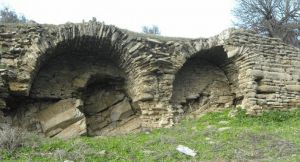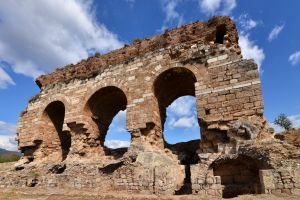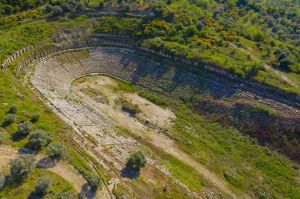The ancient city of Myus
The ancient city of Myus
The date of Myus is M. Oh, my God. It dates back to the 12th century and was ruled by the Kingdom of Lydia. It dates back to the 11th century and was ruled by the Kingdom of Lydia. Later, it came under the rule of the Persian Empire, and with Alexander's conquest of the Persian Empire, M. Oh, my God. It became part of the Hellenistic world in the 4th century. It became part of the Hellenistic world in the 20th century.
Myus is located on the banks of the Menderes River and was considered an important port city in ancient times. The city was especially famous for its timber and olive oil trade. Among the most important structures of the city are the theater, the agora, the stoa (columned street), the gymnasium, the baths and the temples. In addition, there are some remains from the period of the Roman Empire.
Myus remained an important settlement during the Christian period. However, it was abandoned after the Arab influx in the 7th century. It was abandoned after the Arab influx in the 20th century. Today, the remains of the Ancient City of Myus are located near the county of Söke and can be visited by visitors.
The Ancient City of Myus, of Lake Bafa On the shore the ancient city, I did. It's 45 kilometers from the center. According to the information obtained from the borders of Strabo, the city is located at a distance of 30 km from Söke. We're sure you'll forget all about the trouble you'll have to go through when you get to the city.
Where is the ancient city of Myus?
The ancient city of Myus Clear . It is located about 30 km south of the county seat of Söke. To get there, you have to use Söke Muradiye Street to go towards the neighborhood of Özbaşı, after the mirrors of Özbaşı, follow the signs towards Çalıkoy in the direction of the Lake of Torment and reach the Ancient City of Myus.
What is the transportation of the ancient city of Myus?
The ancient city of Myus, The wreckage at the port of Menderes still exhibits a desolate and abandoned appearance; It's a long way from the busy highways, and it's attracted very few visitors. In addition to the fact that there is no road at all, access is provided by footpaths and dirt roads. It's M. From the beginning. If you want to go, you have to go to the ancient city of Myus in your own vehicle.
What to Do in the Ancient City of Myus
The ancient city of Myus location The city of Myos, which remains in ruins, has not been properly cared for as it is underused. It's a quiet, quiet place away from the hustle and bustle of the city for those who want to take a walk or watch the sunset. In the area where he is. There's no rest facility. Don't forget to take your camera with you, because as small as it is, it has a unique view. You might want to immortalize this moment. There is no private camping area. The roads may not be very suitable for caravan travel either.
How many days does it take to walk around the ancient city of Myus?
The ancient city of Myus It's 40 km from the city center and you have to walk along the paths, so you can take the whole day to enjoy the area, or the nearby Old Gullubahçe, Doğanbey Village, The ancient city of Priene This is Mr. Ilyas Cam. I 'm You can go and eat.
Can You Camp in the Ancient City of Myus?
In the ancient city of Myus There's no private camping facility. Still, those who want to can, of course.
The ancient city of Myus
Information about the ancient city of Myus According to information obtained from the writings of Strabo, it is known that it was made by the son of the King of Athens, Codros, named Kydrelos. of Lake Bafa One of them. The nearest ancient city is Avşartepe, 30 km from Söke. The city, which lies in the shadow of the ancient city of Miletus, is home to mosquitoes because of the muddy soil from the surrounding river. Their happiness was short-lived because of the prevalence of malaria and people's fight against the disease. That's why. It was abandoned and considered one of the most secluded and worthless of the Ionian cities. The ancient city of Myos had its heyday in the 5th century, when it joined the Athenian-Delos Maritime Union. He lived in the 19th century. The first excavation work in the city was started in 1908 during the Ottoman state. The German team that continued the excavations of Miletus also worked in Myus. At least the remains have been removed from this area due to the fact that the people of the region took away their portable belongings, looted the area over time and did not use it as a residential area again. It is observed that the experiments carried out on a small scale in 1964 did not bring about a significant change in what is known. The fewest finds ever excavated in the Ionian have been removed from this area. This has both devalued and isolated the region.
Let's take a look at the structures found in this area together: There is a temple in the Doric order. The temple donors are known to belong to the Gum Tree God Apollo Terbintheos. From the side walls against it with the foundations The stretching and peristalsis columns have come down to us through a series of circular pits. Made of large stones, it supports the Cyclops on top of a wall, and the lower terrace limits it from the side. The Temple of Dionysus mentioned by Pausanias is on the terrace below. What remains of the temple from the past to the present day, due to the material used, is a section of the foundations with an inner wall and a single column of white marble. The foundations of the Temple of Dionysus, made of white marble, can still be seen, but there seem to be no other standing remains. From the buildings, we can easily see the religious beliefs of the local people.
Unlike this area, the main settlement is on the second hill to the east. Here are the designs of walking houses, tombs and shrines carved into the rocks. Despite the ongoing excavations at Myus and the lack of modern construction in the area, the rarity of carved stones at the site is explained by the possibility of such a cemetery being moved to Miletus for reuse.
As you drive to the ancient city on the excavated ruins, see the remains of a castle from the Young Roman period. The area is more suitable for off-road vehicles as it is for a bushy terrain and at some points it is necessary to make a difficult hike. You can watch the shoes you're wearing.






Değerlendirmeler